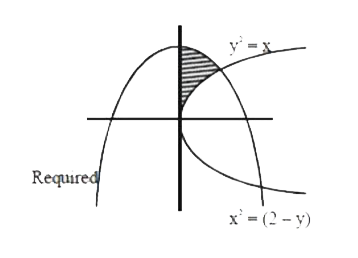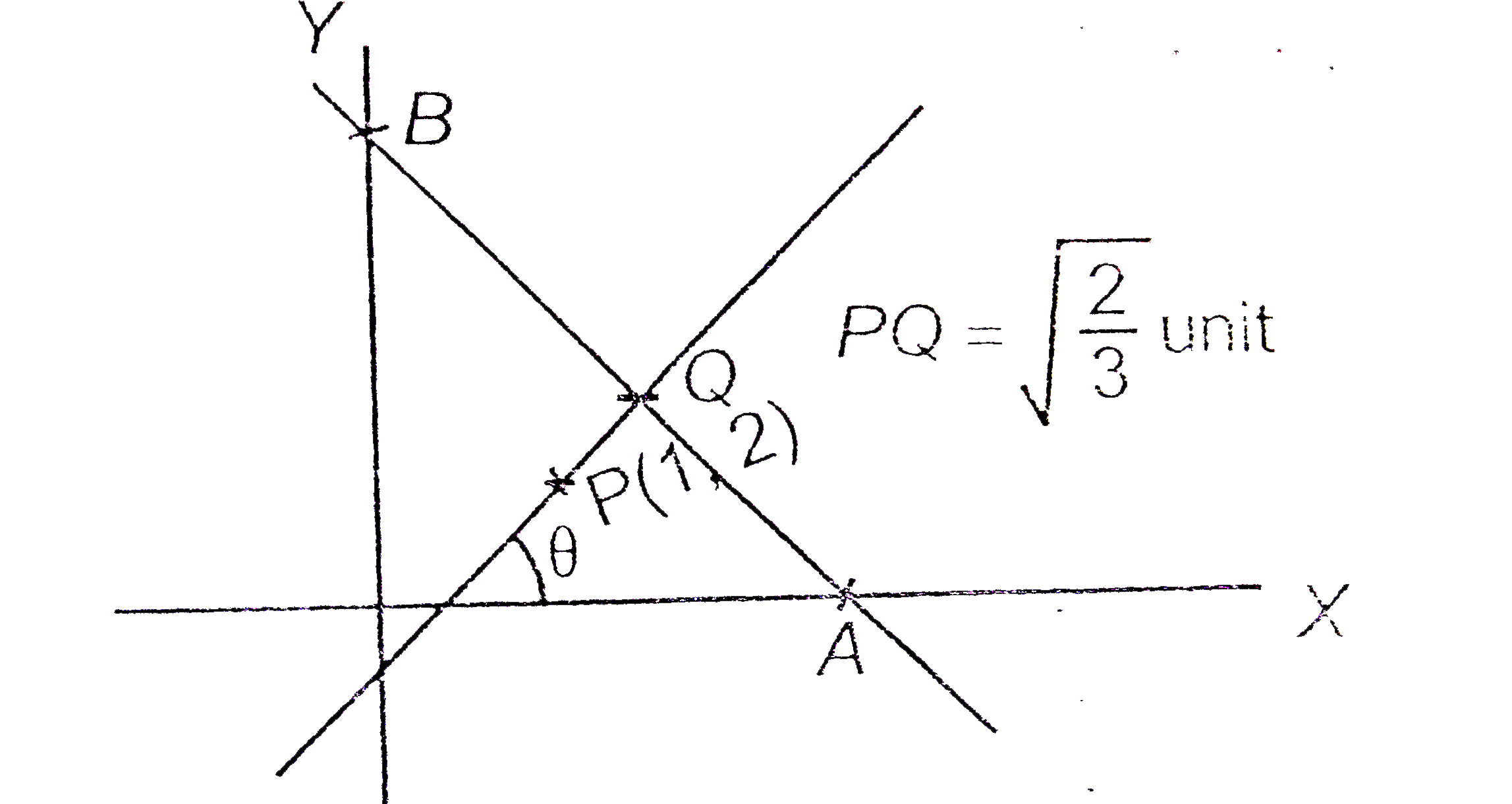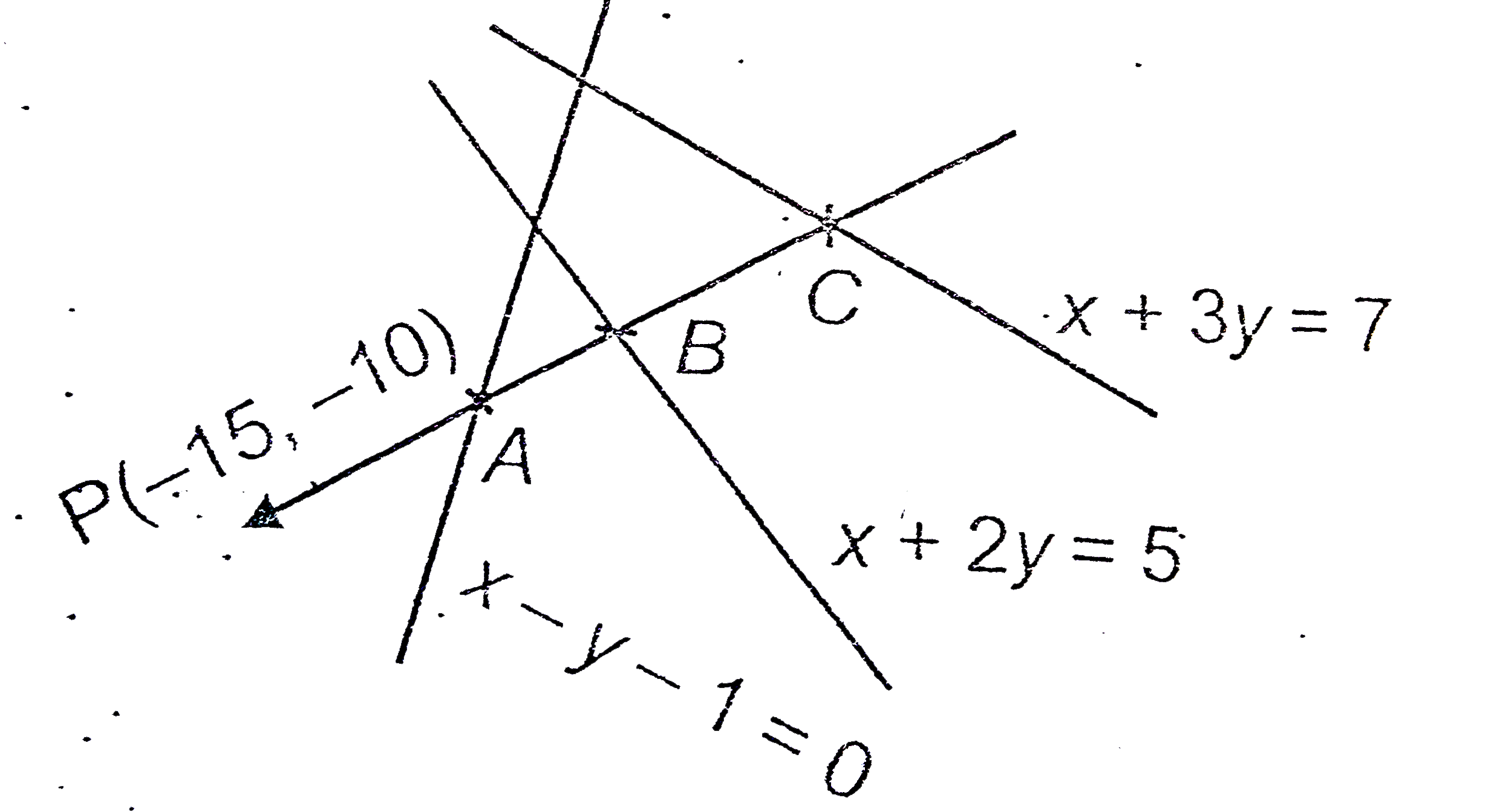InterviewSolution
This section includes InterviewSolutions, each offering curated multiple-choice questions to sharpen your knowledge and support exam preparation. Choose a topic below to get started.
| 751. |
A subset of the additive group of real numbers which is not a sub group is |
|
Answer» `({0}, +)` |
|
| 752. |
Forthe equation |x^(2)| + |x| -6=0, the roots are |
|
Answer» Real and equal |
|
| 753. |
Read the following passages and answer the following questions (7-9) Consider the integrals of the form l=inte^(x)(f(x)+f'(x))dx By product rule considering e^(x)f(x) as first integral and e^(x)f'(x) as second one, we getl=e^(x)f(x)-int(f(x)+f'(x))dx=e^(x)f(x)+c int((1)/(lnx)-(1)/((lnx)^(2)))dx is equal to |
| Answer» Answer :C | |
| 754. |
{:(" "Lt),(n rarr oo):} ((1)/(sqrt(2n-1^(2)))+(1)/(sqrt(4n-2^(2)))+(1)/(sqrt(6n-3^(2)))+....+1/n)= |
|
Answer» `pi/4` |
|
| 756. |
int tan^-1 sqrtx dx is equal to: |
|
Answer» `(X+1)tan^-1 SQRTX-sqrtx+c` |
|
| 757. |
Evaluate the following:lim_(xtoinfty)log_e(1+a/x)^x |
|
Answer» SOLUTION :`lim_(xtoinfty)log_e``(1+a/X)^x` `=log_e{lim_(xtoinfty)(1+a/x)^x}` `log_ee^a=alog_e` `e=a[thereforelim_(x to INFTY)(1+a/x)^x=e^a |
|
| 758. |
If (a + ib)^5 = alpha+ibeta then (b + ia)^5 is equal to |
|
Answer» `beta+ialpha` |
|
| 759. |
int (dx)/(sqrt(1 - x^2)) is equal to : |
|
Answer» log|x+sqrt(1-x^2)|+C |
|
| 760. |
Assertion (A) (x^(2)-1)/(x^(2))e^(x^(2)+1)/x dx = e^(x^(2)+1)/x + c Reason ( R) intf^(')(x)e^(f(x))dx = f(x) +c |
|
Answer» Both A and R are true and R is the correct explanation of A |
|
| 761. |
The shortest distance between the line r = (I + 2j + 3k) + t (I + 3j + 2k) and r = (4i +5j + 6k) + t (2i + 3j + k) is |
|
Answer» 3 |
|
| 762. |
Findthe areaof theregionboundedby theparabolay^2 = 2pxand x^2 = 2py. |
|
Answer» |
|
| 763. |
Find the maximum and minimum values in the following functions :x^(3)-9x^(2)+15x-1, |
|
Answer» Minimum value `-36` at x = 5 |
|
| 764. |
Find the value of [a] if the lines (x-2)/3= (y +4)/2 =(z -1)/5" & " (x +1)/(-2) =(y -1)/3 = (z -a)/4 are coplanar (where [] denotes greatest integer function) |
|
Answer» |
|
| 765. |
The solution of (x)^(2)+(x+1)^(2)=25 (where (.) denotes the least integer function) is |
|
Answer» (2, 4) |
|
| 766. |
Rectangle A has twice the area of Rectangle B. The width of Rectangle A is less than 1/2 the width of Rectangle B. {:("Quantity A","Quantity B"),("The area of Rectangle A","The area of Rectangle B if its"),(,"width is increased by more"),(,"then 2"):} |
|
Answer» Quantity A is greater. |
|
| 767. |
If A is any aquare matrix of order 3xx3 then |3A| is equal to |
|
Answer» a.`3|A|` |
|
| 768. |
If f(x+y)=f(x)+f(y) AA x, y in R and f'(0) exists and sum_(r=16)^(40)intf(x)dx=20900. Then find the area of the region R that in completely bounded by the graph of y_(1)=f(x)-1 and y_(2)=x^(2)-4. |
|
Answer» |
|
| 769. |
Sigma_(r=1)^(oo)tan^(-1) (2/((r +2))) is |
|
Answer» `pi - (TAN^(-1) 2 + tan ^(-1) 3) ` |
|
| 770. |
If m gt 0, n gt 0, the definite integral l=int_(0)^(1)x^(m-1)(1-x)^(n-1)dx depends upon the vlaues of m and n and is denoted by beta(m,n), called the beta function. E.g. int_(0)^(1)x^(4)(1-x)^(5)dx=int_(0)^(1)x^(5-1)(1-x)^(6-1)dx=beta(5, 6) and int_(0)^(1)x^(5//2)(1-x)^(-1//2)dx=int_(0)^(1)x^(7//2-1)(1-x)^(1//2-1)dx=beta((7)/(2),(1)/(2)). Obviously, beta(n, m)=beta(m, n). If int_(0)^(oo)(x^(m-1))/((1+x)^(m+n))dx, then k is equal to |
|
Answer» `(m)/(N)` |
|
| 771. |
If (a+bi)^(11) = x + iy, where a, b, x, y in R, then (b + ai)^(11) equals |
| Answer» Answer :B | |
| 772. |
If a vector vecr is equall inclined with the vectors veca=costhetahati+sinthetahatj, vecb=-sinthetahati+costhetahatj and vecc=hatk, then the angle between vecr and veca is |
|
Answer» `cos^(-1)(1/sqrt(2))` `vecb=-sinthetahati+costhetahatj` and `vecc=hatk` `|veca|=|vecb|=|vecc|` and `veca.vecb=vecb.vecc=vecc.veca` `therefore` Required angle is `cos^(-1)(1/sqrt(3))` |
|
| 773. |
If alpha, beta , gamma are the roots of 2x^(3)-2x-1=0, ( Sigma alpha beta)^(2) is equal to |
|
Answer» `B+q` |
|
| 774. |
Read the following passages and answer the following questions (7-9) Consider the integrals of the form l=inte^(x)(f(x)+f'(x))dx By product rule considering e^(x)f(x) as first integral and e^(x)f'(x) as second one, we get l=e^(x)f(x)-int(f(x)+f'(x))dx=e^(x)f(x)+c inte^(x)((1+sinxcosx)/(cos^(2)x))dx is equal to |
|
Answer» e^(X)F(x)+c` |
|
| 775. |
Find k if the following pairs of circles are orthogonal x^2+y^2-16y-k=0 x^2+y^2+4x-8=0 |
|
Answer» |
|
| 776. |
Match the values of x in List II where derivative of the function in List I is negative. |
|
Answer» <P> Solution :`ararrp,R,brarrq,s,crarrq,r,drarr.`a. p,q,r The GRAPH of `y=|x^(2)-2|x||:`  From the graph, `dy//dx` is negative for `(p),(q),(r)` b. q,s The graph of `y=|log|x||:`  ltbvrgt From the graph, `dy//dx` is negative for (q),(s). ltbvrgt From the graph, `dy//dx` is negative for (q),(s). c. q,r `y=x[x//2]={{:(-2x",",-4lexlt-2),(-x",",-2xlexlt0),(0",", 0le XLT 2),(x",", 2ltxlt4):}` Hence, `dy//dx` is negative for (q), (r) d. r The graph of `y=|sin x|`  From the graph, `dy//dx` is negative for (r). |
|
| 777. |
Ifalpha , beta in (0,pi/2), sinalpha =4/5andcos( alpha+ beta) = ( -12)/(13)then sinbetais equalto |
| Answer» Answer :A | |
| 779. |
Let L_(1):(x-2)/(2)=(y-3)/(-1)=(z-1)/(3),L_(2):(x-2)/(-1)=(y-3)/(3)=(z-1)/(5/3) and L_(3):(x-2)/(-32)=(y-3)/(-19)=(z-1)/(15) are three lines intersecting each other at the point P and a given plane at A,B,C respectively, such that PA=2,PB=3,PC=6. The volume ( in cubic units) of the tetrahedron PABC is |
|
Answer» 2 |
|
| 780. |
Let S be the standard deviation of n observations. Each of the n observations is multiplied by a constant c. Then the standard deviation of the resulting numbers is : |
| Answer» ANSWER :B | |
| 781. |
Let A = {1, 2, 3) and B= {a,b,c}, andf= {(1, a),(2, b), (P, c)} be a function from A to B. For the function f to be one-one and onto the value of P = |
|
Answer» 1 |
|
| 782. |
Evaluate int_(0)^(t)[|sin^(-1)(sinx)|]dx" where "tin(2npi,(8n+1)(pi)/(4)). |
|
Answer» |
|
| 783. |
Find the value of the sqrt199correct to 4 decimal places |
|
Answer» |
|
| 784. |
Let 'A' be the area bounded by the curves y^(2) = 4k_(1)x, k_(1) in [1/8, 1/4] x^(2) = 4k_(2) (2-y), k_(2) in [1/4, 1] and y-axis in the first quadrant. Then the least value of A is |
Answer»  Required `A=int_(0)^(1)(2-X^(2) -sqrt(x)) DX` `=2-1/3 - 2/3 = 2-1=1` |
|
| 785. |
If A(-2, 1), B(0, -2), C(1, 2) are the vertices of a triangle ABC, then the perpendicular distance from its circumcentre to the side BC is |
|
Answer» A.`(7sqrt(13))/22` |
|
| 786. |
The point of contact of 9x+8y-11=0 to the hyperbola 3x^(2)-4y^(2)=11 is |
| Answer» ANSWER :A | |
| 787. |
If an arithmetic series sumtn converges, which of the following is true about t_n? |
|
Answer» `t_nlt1` |
|
| 788. |
Find underset(n to oo)lim x_(n) if (a) x_(n=sqrt(2n+3)-sqrt(n-1) (b) x_(n)=sqrt(n^(2)+n+1)-sqrt(n^(2)-n+1), (c) x_(n)=n^(2) (n-sqrt(n^(2)+1)) (d) x_(n)=root3(n^(2)-n^(3))+pi (e) x_(n)=(sqrt(n^(2)+1)+sqrtn)/(root5(n^(3)+n-sqrtn) (f) x_(n)=root(n+1)^(2)-root3(n-1)^(2), (g) x_(n)=(1-2+3-4+5-6+...-2n)/(sqrt(n^(2)+!)+sqrt(4n^(2)-1)) (g) x_(n)=1/(1.2)+1/(2.3)+(1)/(3.4)+.....+(1)/(n(n+10) |
|
Answer» |
|
| 789. |
Box-I contains 2 gold coins, while another Box-II contains 1 goldand 1 silver coin. A person chooses a box at random and takes out a coin. If the coin is of gold, what is the probability that the other coin in the box is also of gold? |
|
Answer» |
|
| 790. |
If (1)/(3){:[(1,2,3),(2,1,-1),(-2,2,-1):}] and A*A^(T)=I A^(-1) is |
|
Answer» `-A` |
|
| 791. |
int(x^(9))/((4x^(2)+1)^(6)) dx |
|
Answer» `(1)/(5x)(4+(1)/(x^(2)))^(5)` |
|
| 792. |
Solve the following Linear Programming Problems graphically : Maximise Z = 5x + 3y subject to 3x+5y le 15, 5x+2y le 10, x ge 0, y ge 0 |
|
Answer» <P> |
|
| 793. |
Find the area of the region enclosed by the given curves . y=cosx , y=sin2x , x=0, x=(pi)/(2) |
|
Answer» |
|
| 794. |
(i) Find the direction in which a straight line must be drawn torough the points (1,2) so that its point of intersection with the line x+y=4 may be the a distance sqrt((2)/(3)) from this point. (ii) A straight line through P(-15,-10) meets the straight lies x-y-1=0,x+2y=5and x+3y=7 respectively at A,B and C, if (12)/(PA)+(40)/(PB)=(52)/(PC), then prove that the straight line passes through origin. |
|
Answer» <P> Solution :(i) Let the straight line through `P(1,2)` cut the given straight line `x+y=4` at Q and the straight line is inclined at an angle `theta` with positive direction of x-axis. Then its equation is `(x-1)/(costheta)=(y-2)/(sintheta)=r,PQ=r.`The coordinates of the point Q are `(1+r cos theta, 2+r sin theta)` Which lies on `x+y=4` `impliessqrt((2)/(3))(cos theta+sin theta)=1,r=sqrt((2)/(3)),` given `impliescos theta+sin theta=sqrt((3)/(2))` `IMPLIES(1)/(sqrt(2))costheta+(1)/(sqrt2)sin theta=(1)/(sqrt2)sqrt((3)/(2))=(sqrt3)/(2)` `impliescos(theta-(pi)/(4))=cos""(pi)/(6)` `impliestheta-(pi)/(4)=(pi)/(6)or -(pi)/(6)` `impliestheta=(pi)/(4)+(pi)/(6)or (pi)/(4)-(pi)/(6)` `impliestheta=(5pi)/(12)or =(pi)/(12)`  (ii) Let the equation of straight line passing THROUG `P(-15,-10)` be `(x+15)/(costheta)=(y+10)/(sin theta)` which cuts the given straight LINES `x-y-1=0,x+2y=5andx+3y=7` at A, B  and C respectively. Any point on this line may be takes as `(-15+rcostheta,-10+rsintheta)` For the coordinates of the point `A,(-15rcostheta,-10+r sin theta)` lies on `x-y-1=0` `implies-15+r cos theta+10-r sin theta-1=0` `impliesr (cos theta-sin theta)=6` `implies(6)/(PA)= cos theta-sin theta` Also for `B,l15+r cos theta-20+2rsin theta=5` `impliesr(cos theta+2sin theta)=40` `implies(40)/(PB=cos theta2 sin theta` and for the point `C,15+r cos theta-30+3rsin theta=7` `impliesr(cos theta+2sin theta)=52` `impliescos theta+3sin theta=(52)/(PC)` Now from the given condition, `(12)/(PA)+(40)/(PB)=(52)/(PC)` `implies2(cos theta-sin theta)+costheta+2sintheta=costheta+3sintheta` `implies2cos theta=3sinthetaimplies(cos theta)/(3)=(sin theta)/(2)` Hence the required equation of the straight line is `(x+15)/(3)=(y+10)/(2)` `implies2x+30=3y+30` `implies2x-3y=0` which passes through ORIGIN. |
|
| 796. |
If the line x=y=z intersect the line xsinA+ysinB+zsinC-2d^(2)=0=xsin(2A)+ysin(2B)+zsin(2C)-d^(2), where A, B, C are the internal angles of a triangle and "sin"(A)/(2)"sin"(B)/(2)"sin"(C)/(2)=k then the value of 64k is equal to |
|
Answer» |
|
| 797. |
If thelocus of the complex number z given by arg(z+i)-arg(z-i)=(2pi)/(3) is an arc of a circle, then the length of the arc is |
|
Answer» `(4pi)/(3)` |
|
| 798. |
if |{:(a^(2)+lamda^(2),ab+clamda,ca-blamda),(ab-clamda,b^(2)+lamda^(2),bc+alamda),(ca+blamda,-bc+alamda,c^(2)+lamda^(2)):}||{:(lamda,c,-b),(-c,lamda,a),(b,-a,lamda):}|=(1+a^(2)+b^(2)+c^(2))^(3), then find the value of lamda |
|
Answer» HENCE, `L.H.S=|{:(lamda,C,-b),(-c,lamda,a),(b,-a,lamda):}|^(3)=[lamda(lamda^(2)+a^(2)+b^(2)+c^(2))]^(3)=(1+a^(2)+b^(2)+c^(2))^(3)implieslamda=1` |
|
| 799. |
If f (x) ={{:( xcos ((1)/(x)) ,"for " xne 0),( 0,"for " x=0) :},then at x =0 |
|
Answer» F(x) is not CONTINUOUS |
|
| 800. |
Let x_(1), x_(2), …… , x_(n) be in an A.P. If x_(1) + x_(4) + x_(9) + x_(11) + x_(20) + x_(22) + x_(27) + x_(30) = 272, then x_(1) + x_(2) + x_(3) + ...... + x_(30) is equal to |
|
Answer» 1020 |
|